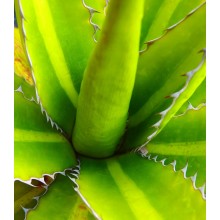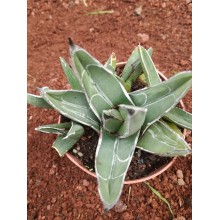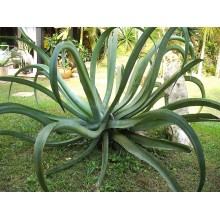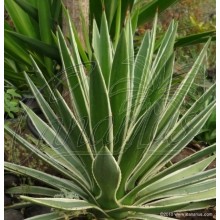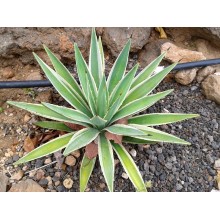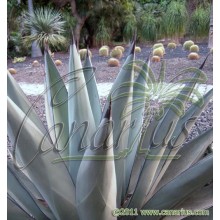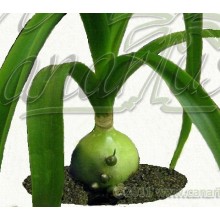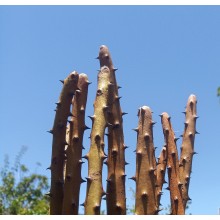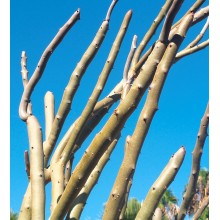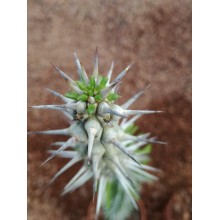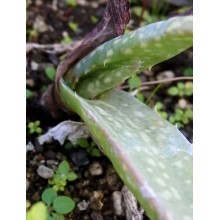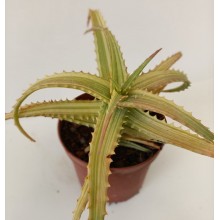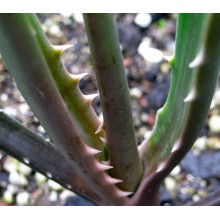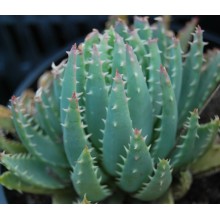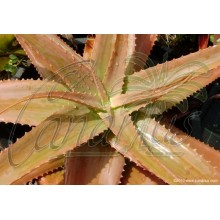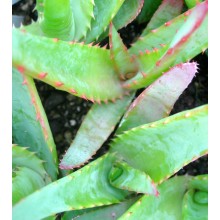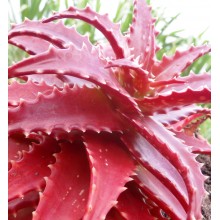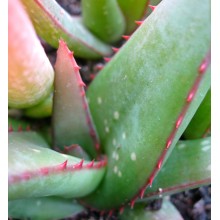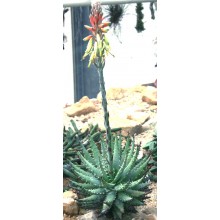Succulents There are 628 products.

World deserts and dry areas are home to the most interesting plants. Canarius offers an increasing selection of succulent plants of maximum quality, because they are grown outdoors, under the full sun of the Canary Islands.
Succulents or "fat plants" are water-retaining species, adapted to dry conditions. They store succum (juice, water) in their leaves, stems or roots, and often show a stout and fleshy appearance.
Subcategories
-
Agave
Agave is a genus of succulent plants from America. Some species grow in cold areas and take hard frost, while some others live in tropical climates. Some are tiny dwarfs and some are giants, up to 2 or 3 m wide.
Cold hardy agaves can create an exotic effect in your garden. Agave species make fine companions to palms or cacti. Variegated agaves are incredibly sought after by collectors. Our web shop offers an ever changing selection of species. We ship bare rooted plants, unless otherwise specified.
-
Aloe, Gasteria & Haworthia
Aloe, Gasteria and Haworthia are three related genera, comprising hundreds of succulent plants. They are all easily grown in pots. A few adapt to low-light levels of indoor conditions and can be grown as house plants.
- Aloe is a genus of about 400 species, native to Africa, Arabia and Madagascar. Small or dwarf aloes are becoming especially popular in colder climates as they can be taken indoors during the hardest months.
- Gasteria includes some 80 species endemic to South Africa, known for their spectacular leaves which are glossy, mottled and textured. They bloom in Spring-Summer with long spikes of small orange flowers. Some species are so variable that we offer particular clones from specific locations.
- Haworthia is a genus endemic to South Africa with about 70 species and a number of local subspecies, varieties and forms. Leaves are often banded, speckled, dotted, or semi-translucent and show wide variations.
-
Crassulaceae
This is a new, growing section of species from the family Crassulaceae. There are about 1,400 species in 33 genera and their distribution is worldwide, but mostly occur in the Northern Hemisphere and Southern Africa, especially in dry habitats. Here you can buy healthy, sun-hardened plants grown in the Canary Islands and shipped to your home.
-
Mesembs
This group of desert plants is briefly named Mesembs because they belong to a botanical family formerly named Mesembryanthemaceae. There are almost 2.000 species, mainly found in Southern Africa, with extreme adaptations to dry habitats. Some are called "living stones", as they look like pebbles. Many are easy to grow and their main need is full sun. Some are difficult because they grow in truly extreme areas.
Our Web Shop offers sun grown healthy plants, with compact and colourful leaves. Some plants are sold as cuttings, and others as rooted plants, of at least two years old.
-
Sansevieria
Recently assigned to the family Asparagaceae, the genus Sansevieria counts about 70 species, nearly all native to Africa, Arabia and Madagascar. Perennial herbs adapted to dry habitats with stiff, succulent leaves, their length ranges from a few centimeters to 2 meters. Sansevieria trifasciata and its many cultivars are among the most popular houseplants, popularly called mother in law's tongue. A well grown plant usually produces a spike of many white, richly scented flowers and then orange berries. Even the rarest species are resistant to neglect, provided you keep them from frost in winter and scorching sun in summer.
-
Hoya
Hoyas are twining vines, with showy exotic flowers, from the rainforests in Asia and Oceania. Most species grow in bright shade or morning sun, but they will also grow indoors as house plants. They are well suited for baskets, trellises or ladders. They tolerate a few weeks of drought but they are sensitive to frost and cold. Many hoyas are easy to grow and bloom, while some are tricky and rare.
-
Asclepiads
Asclepiads or Asclepiadoideae are a subfamily in the Apocynaceae, with about 2900 species. There are lots of leafless stem succulents but also perennial herbs, shrubs, lianas or rarely trees. They produce remarkable flowers, for the complex mechanisms they have developed for pollination. Many species produce an unusual fragrance, often called "carrion", and attracts flies for pollination. -
Caudiciforms
These plants from dry areas produce an unusually thick stem, the caudex. They are also called pachycauls and they have a disproportionately thick trunk, often with few branches. The caudex can be hidden underground, but in most cases they grow upwards, forming spectacular trees. The largest caudiciforms in the world are the baobabs. -
Other succulents
Here you will find all those species of desert plants that are not included in their own category. We will place here all plants from unusual families, other than Agaves, Aloes, Crassulaceae, Sansevieria, Mesembs, Epiphytic cacti, etc.
-
Agave univittata 'Splendida'
Agave univittata 'Splendida'
This small, frost-hardy agave is a non-hybrid clone selected in cultivation, with enhanced colours. Leaves are darker, with a paler central stripe, all is glossy and the leaf margins are almost white. It is frost resistant to -15 C or more if kept dry!
27,50 € -
Agave victoriae-reginae 'Ferdinandi-regis'
Agave victoriae-reginae 'Ferdinandi-regis'
Until recently, Agave ferdinandi-regis was considered a fully different species. It is a very elegant Agave, less compact than victoriae-reginae with dark reddish brown edges (not silvery). It is solitary or very slow to sucker, globose, slow growing up to 45 cm.
17,20 € -
Agave vilmoriniana
Agave vilmoriniana
A totally different spineless Agave unlike any other, with a smooth spreading rosette of elegantly curving leaves. Its unmistakeable "octopus shape" is a highlight both in a succulent collection and in the exotic garden.
26,40 € -
Agave vivipara 'marginata'
Agave vivipara 'marginata'
13-17 cm. This is a popular species, commonly seen in Mexican and Caribbean gardens. Fantastic shape with olive-green leaves with white margins and black spines.
11,40 € -
Agave x Nigra
Agave x Nigra
10-14 cm diameter - Nigra is a "classic" hybrid Agave, obtained by crossing Agave victoriae-reginae and A. scabra. Agave X nigra is a beautiful frost-hardy plant, known for its architectural shape.
17,50 € -
Albuca bracteata
Albuca bracteata
Unusual bulbous plant with a showy, glossy green bulb growing above ground, up to 10 cm in diameter. Long pale-green leaves and tall spikes of fragrant flowers. Easy growing. It takes hard drought and frost to about -4 C.
13,70 € -
Alluaudia dumosa
Alluaudia dumosa
Succulent shrub from SW Madagascar, with brown-grey stems, with a rough texture, regularly dotted with of clusters of short, dark spines.
24,30 € -
Alluaudia dumosa - Large
Alluaudia dumosa - Large
Succulent shrub from SW Madagascar, with brown-grey stems, with a rough texture, regularly dotted with of clusters of short, dark spines.
79,20 € -
Alluaudia procera
Alluaudia procera
A symbol of Southern Madagascar. Didierea procera builds a vertical, columnar structure which is very elegant despite its thorns.
32,00 € -
Aloe abyssicola
Aloe abyssicola
We offer a 8-14 cm rooted plant. This is a distinctive mid-sized aloe that grows on cliffs, in Yemen. Rosettes grow asymmetrically on a side, with beautiful, wide dull mottled leaves with widely spaced spines.
29,40 € -
Aloe arborescens 'Variegata'
Aloe arborescens 'Variegata'
This variegated clone of Aloe arborescens is just as easy to grow and to make it bloom as the true species, which is a popular ornamental shrub from South Africa. It just grows a bit slower and smaller. Leaves are jade-green, with yellow stripes.
34,00 € -
Aloe barberae - Large
Aloe barberae - Large
The largest of all aloes. This South African aloe tree grows as huge as a Dracaena draco and can attain 6-16 m in height. It takes light frosts and it is a must for Mediterranean gardens.
148,00 € -
Aloe brevifolia
Aloe brevifolia
Smaller leaved form of a low growing, clumping aloe. This dwarf form has a very manageable size and it is great for pots. This species from South Africa can stand some frost.
13,80 € -
Aloe bulbilifera var. paulianae
Aloe bulbilifera var. paulianae
Aloe bulbilifera is different because it is viviparous: new pups sprout from the inflorescence and grow larger when the red flowers are gone. This is the variety called paulianae. It has an elegant rosette turning copper-pinkish in full sun.
15,20 € -
Aloe bulbilifera var. paulianae - Large
Aloe bulbilifera var. paulianae - Large
Rosette 30 - 50 cm diam. Aloe bulbilifera is different because it is viviparous: pups sprout from the inflorescence and grow larger when the red flowers are gone. This is the variety called paulianae.
22,70 € -
Aloe comosa
Aloe comosa
We offer a 13-18 cm diameter plant. This large stemmed aloe grows to a height of 1-3 m, unbranched. The bold rosette has a rusty-copper colour. It blooms with tall multiple spikes of red and yellow flowers. It is native to a small area close to Clanwilliams, e Western Cape.
15,20 € -
Aloe dorotheae - Large
Aloe dorotheae - Large
This is one of the most colourful low-growing aloes, a delightful garden plant with glossy cherry-red leaves when exposed to full sun. It is becoming increasingly popular in Tenerife, while it is critically endangered in the wild.
38,80 € -
Aloe elegans Ethiopia
Aloe elegans Ethiopia
Mid-sized stemless Aloe, widespread and locally abundant in northern Ethiopia and in Eritrea. It grows solitary or forming small groups. It grows on rocky slopes, mostly on sandstone or limestone, in areas with evergreen bushland or wooded grassland. This batch is from Ethiopian populations.
16,50 € -
Aloe erinacea
Aloe erinacea
Collector's aloe from harsh dry mountains in Namibia. It is a small gem with green-gray leaves full of white spines often tipped in red. It does not like to be overwatered!
12,50 €
At the moment there are few products in this category Succulents

























